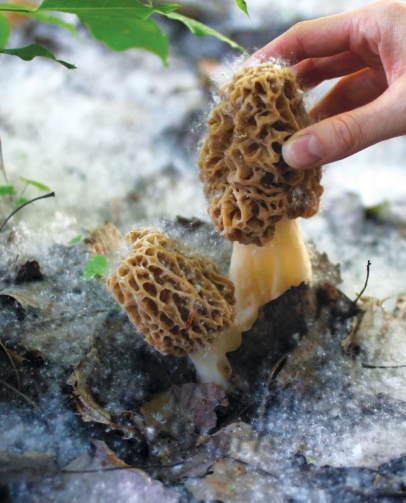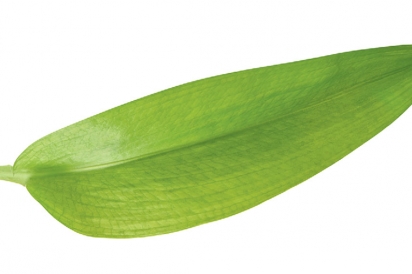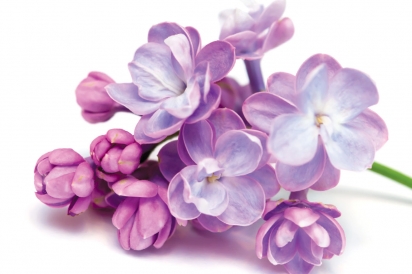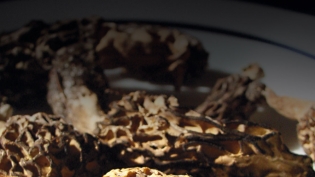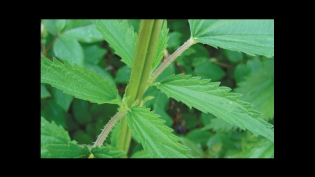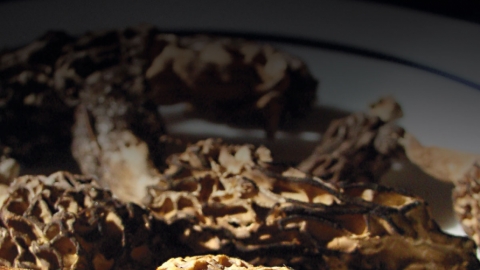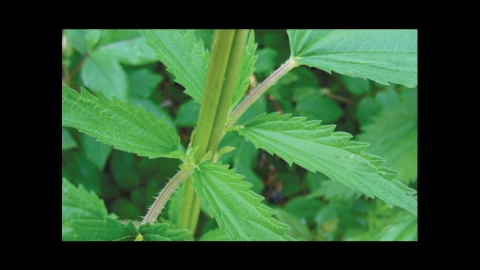The Mystique of Morels
There are rites of passage to becoming a local in Northern Michigan, and the first morel hunt is a special one. For me, it was an early spring afternoon five years ago. The sun was skimming through the lower branches of the cherry orchard, the open fields were just beginning to green and the temperature called for at least one sweater over my T-shirt—though by mid-day a spot sheltered from the wind could lure you to shed a layer.
I’d been going on about morels for a bit when my dear friend/adopted parent Gene grabbed a couple of red mesh onion bags stashed behind the basement door and told me to come along. We hopped into his dusty blue pickup truck and headed out through the orchards, woods and fields on his farm at the tip of Leelanau County. Stopping the truck by the edge of a dirt road, or by a patch of woods, or... he’d step out and stride into the woods, me following obediently, up a bank, down another, then stop and look at me. I’d glance down to see a morel the size of my 10-year old’s fist.
On a mission, Gene led me through one patch to another, our bags growing ever fuller, my fungus-spotting skills growing by a smidgeon. In the orchard grasses I glimpsed wild asparagus stalks standing tall. Recognizing them as a link to my past life in Provence, I gleefully ran to snap the tops at the sweet spot. That evening, sautéed morels, wild asparagus omelet, hunks of my multi-grain bread and a good red wine filled our bellies.
Morels. Yes, we love eating them, but even more they evoke reactions— tactile, sensory, visual, spiritual and emotional. What is this thing about them? Be you new to the region, fourth generation or with roots that go far deeper, I think you’ll relish these shared musings of neighbors and colleagues as I do.
TONY WILLIAMS: Five-time National Morel Hunting Contest winner and festival expert in residence, Boyne City
As soon as we get done boiling sap I’ll be out there picking mushrooms. The seasons run together. We still have a good month ‘til we know whether it’ll be a good year. We could use a crush of rain.
For me, mushroom picking revolves around family. I grew up in it. My grandfathers came here to cut the pine in the Boyne City region. My grandfather Homer married a French-Indian woman. Her father came from France, late 1800s—where he’d picked morels. My family has been picking mushrooms in this area for 130 years.
The modern world has taken us out of the woods. When I was growing up, my mother would pack a big picnic and we would throw the whole family in the car, leave right after breakfast and be gone for the day. We’d play in the woods, my brothers and sisters and I, and we’d pick morels. My parents were great morel pickers and they taught us both about the morels and about being in the woods. I’ve tried to turn my kids on to this. When I was a kid we had a million spots to go. Morels come back to the same spots. My family had all these fantastic spots, passed down over the generations. But a lot of them are disappearing to developments.
You get back in touch with nature. And you get in touch with the planet when it hands you food, rather than going to a grocery store. We’ve got to be taking our kids and grandkids out and turning them on to the planet.
JENNIFER BLAKESLEE: Chef and co-owner of The Cooks’ House, Traverse City
For me, morels are spring. They are the most enjoyable reward for surviving winter. Everything is blooming again. They represent more ... patience. They’re contingent on the weather. There’s that in-between moment—it’s almost but not quite morel season, hang on a little bit longer, just a little bit more, if it rains right, gets a bit warmer, if everything aligns properly, the morels will be there.
My Gramma would make this morel pasta: morels sautéed in salt and butter, atop her homemade pasta. It was to die for. Or she’d top toast with those buttery morels. When I was little she had these two really cool mushroom prints—one edible and one poisonous—taped to the inside of her kitchen cabinets. I have them now, framed on my walls. They’re a little bit of her world brought into mine.
NATHAN WRIGHT: Herbalist, forager, owner of Herbal Lodge Wild Harvested Remedies, Petoskey
Morels for me are a gift of the forest. The first mushroom of the spring. I can be out looking for them all day, and walk straight over a patch of leaves and twigs, then turn around and it’s as if the forest has moved, and I see them. One time I was out with my daughter and after a long time seeking, suddenly I came across the largest cluster I’d ever seen. I wept. Maybe it was the shifting light—from one hour to the next, the shadows move, the light, everything is different. But I felt as if the forest had moved for me, so that I could see its offering to me.
JULIA BRABENEC: Retired organic fruit farmer, Northport
I am a gleaner at heart. My grandmother, babichka, emigrated from the Ukraine when I was a baby, and one of my special childhood memories of her was foraging for mushrooms in our woods. She would probe with her cane, rustling through the fallen leaves, leaving no stump unexamined and I would follow her eagerly, fascinated by her fervent searching. Morels entered my mushroom fantasies as I roamed the woods of Leelanau County with my husband uncovering all of its bounty. And, of course, learning about the morels that hid amidst the trilliums was the beginning of a favorite spring foraging adventure. I soon learned where the early blacks could be found, and where the Verpa bohemica preferred to show up before the main crop of “whites” began to appear. Whatever amount came home in my basket was always accompanied by some ramps, for what became my husband’s favorite springtime meal: potato pancakes with morel and wild leek gravy.
JERRY DENNIS: Author, co-owner of Big Maple Press, Northern Michigan
A “special place” doesn’t say it strongly enough for me or my family. For us, hunting morels has been a three- and sometimes four-generation obsession for as long as I can remember. In April and May my waking (and sleeping!) hours are haunted by three things: morels, trout and migrant birds. Many days I join my wife, sons, daughter-in-law and, now, granddaughter to search for all three. On the best days we return home with an onion bag or two bulging with morels. My job then is to pour a glass of red wine, turn up the music and set to work gently cleaning them, cutting them into halves or quarters, tossing them in flour and salt, sautéing them in 50/50 butter and olive oil until they’re a lovely, nutty, crunchy brown, and serving them to my family and friends. It’s my favorite thing to do in the spring.
RUTH MOSSOK JOHNSTON: Author, recipe writer and tester, owner of Lot’s Wyfe Salt, Franklin
The key for me and food was always experience. In the 1990s, I met Joe Bridenstein of Walloon Lake. He used to do these mushroom weekends. He’d take people out and forage and I literally would cook up their harvest on the spot. I became hooked on morels, and Joe was a big part of that. One weekend this mushroom expert was there and I made my morel soup recipe and this guy was so crazy about it, he went on and on about it, and then he came and kissed me right smack on the lips. Now normally, I went to these weekends alone, but exceptionally, my husband was with me this time, and I was worried he might wonder what I was doing up here. But my husband, quick as can be, just said, “I’m the husband, aren’t you going to kiss me too?” Every year, I just hold my breath till the season is upon us. (Ruth’s recipe follows on page 20.)
JIM BARNES: Caterer, chef and owner of Crystal Lake Catering Company, Frankfort
Whenever I work with morel mushrooms I want to capture it all, literally. So, when sautéing the mushrooms in butter, garlic, salt and pepper, I always cover the pan so I don’t lose any of the flavor. By collecting the mushrooms’ airborne stock on the underside of the lid, I ensure that not a single ounce of valuable morel flavor is lost. I lift the cover directly above the sauté pan and allow all of the collected moisture to drip right back into the pan. With the pan full of sautéed mushrooms and its stock, I simply add a pat of butter or heavy cream allowing for the creamy conduit to carry the morel flavor onto a pasta, hot with wide-open pores.
GAIA NESVACIL: Flower farmer, goat herdswoman and artist, Cedar
My connection to morel mushrooms goes back to the early ’80s, when I was a beach baby, growing up half naked at Good Harbor Beach. My sister was born in morel season. We went morel hunting on the day of her birth in mid- May. The family story is that we had to be very quiet while searching so that the elves would pop them up. I was smaller than I can remember when I found my first morel. It was the family sport of the springtime, from as early as we could walk. Mom said it was always good luck to bring us with her to forage as our eyes were close to the ground, closer to the elves, in those young years. But from an early age we were always sworn to never give our spot away. We’d save onion sacks from February onward, anticipating the hunts. I knew the word “spore” before I could tie my shoes. It taught us as a family— three little girls and an outdoors mother—to use all of our senses.
MIKE EVERTS: Organic farmer, caterer, Blackbird Gardens, Real Food Dream Kitchen, Petoskey
I’m a lifelong forager and hiker. I live outside and relish any occasion to be in the woods and explore this region, my home. Along with this whole food awareness and movement I find that more people are finding morels and eating them. They’re really popular now. So, my thoughts are to give them a break, to not forget that there are over 20 other varieties of delicious mushrooms up here. The first morel I find each year, I leave, and make an offering to the Great Spirit, to the four directions and the spirit of life that creates this mushroom. I recognize that they need to be respected and we need to limit how much harvesting we do. I think we need to bring a consciousness to wildcrafting. There is a limit to what is sustainable. Mushrooms are the great foundation builders. They create vibrant living leaf mold out of all the yearly residue of the forest and it’s a living thing, that forest floor. The living soil, food web floor, part of the living biosphere. It’s important to resist the temptation to take all that we find.
NANCY ALLEN: Chef, writer and teacher, Maple City
They’re my favorite spring tonic, the harbinger of spring. They’re kind of mystical, hard to find. They hide out. They carry the scent of sex, rich, sensual. There’s no other food like it, except caviar. They’re kind of in the same class for me. I don’t know what else to call it. It isn’t even really umami. It’s just got this kind of wantonness, a scent of wantonness. They really are very, very different from other mushrooms, in a class by themselves.
Because of this quality, I don’t like to do anything much except pair them with things that would enhance and not overwhelm them. Mine and Bill’s favorite way is always just sautéed in butter or ghee, or with eggs. For our wedding, we went up to his favorite morel patch and there were so many white morels. We were greedy and harvested all of them. They were a special gift for our wedding. The next year that morel land was excavated, cleared, and that patch was no longer.
We planned to sauté them in butter, and pair them with local steamed asparagus. But my darling mother found these morels in the freezer—she then chopped them up and put them into her meatballs for my wedding feast! I was so pissed, but god damn those meatballs tasted good.
PAUL OLSON: Chef/managing partner, Jolly Pumpkin Restaurant and Brewery, Mission Table Restaurant, Traverse City
Growing up in a suburb of Detroit, I didn’t see much of them as a kid. When I went to culinary school, I’d never worked with them before. This French guy I worked with in New York was from Burgundy. He was so into it. Cool to see. Then after NY I went to CT and we had this sweet mushroom farmer who’d show up in the spring in this beat-up car and he’d have these grocery bags filled with morels. “I’ll trade you mushrooms for dinner,” he’d say. Cash and dinner, and he’d brought a sketchy friend with him … neither had bathed recently—we put them in a corner of the restaurant— but the mushrooms were awesome.
We lived for 11 years in Newtown, CT—I looked for morels everywhere but had zero success except at a friend’s place, where we found six in the mulch. Then, one year, late summer—the timing was weird—we found one morel under a pine tree in my back yard. A three-inch-high morel, solo, in the sand and needles. Like it’d been planted. It was time to move back to Michigan.
Here in Traverse some of my guys go out foraging all the time. Morels, but also the ramps are amazing. I try to keep pickled ramps, or ramp butter on the menu ’til August.
When I prepare morels, I usually just sauté them with butter, shallots and olive oil. We make a white pizza with them. I like to mix them with asparagus, a couple of pickled ramps at the end. You can put them on anything, pasta, a touch of cream. Keep it simple. Three to five ingredients, keep it easy. That’s the way to eat them.


